The AMD A8-7650K APU Review, Also New Testing Methodology
by Ian Cutress on May 12, 2015 10:00 AM ESTGaming Benchmarks: High End
Alien: Isolation
If first person survival mixed with horror is your sort of thing, then Alien: Isolation, based off of the Alien franchise, should be an interesting title. Developed by The Creative Assembly and released in October 2014, Alien: Isolation has won numerous awards from Game Of The Year to several top 10s/25s and Best Horror titles, ratcheting up over a million sales by February 2015. Alien: Isolation uses a custom built engine which includes dynamic sound effects and should be fully multi-core enabled.
For low end graphics, we test at 720p with Ultra settings, whereas for mid and high range graphics we bump this up to 1080p, taking the average frame rate as our marker with a scripted version of the built-in benchmark.
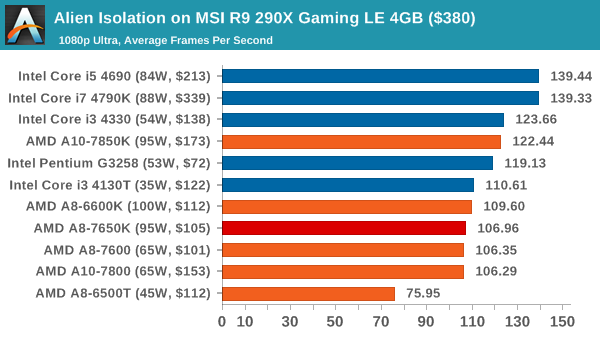
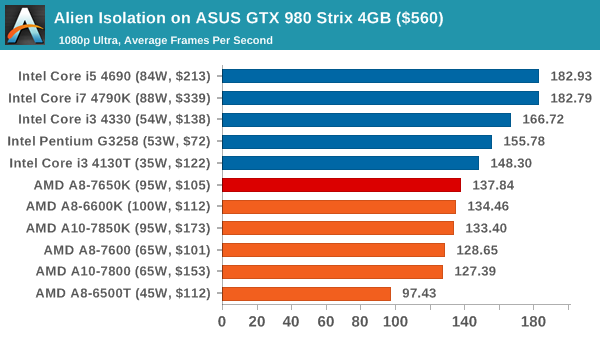
When using the R9 290X, the AMD APUs (except for the 7850K) are within a few percentage points for average frame rates compared to similarly priced Intel processors. You need to spend $200 to get a +30% increase in frame rates. That being said, the frame rates in all our results (except the A8-6500T) were all above 120 FPS on the GTX 980, albeit with the G3258 and i3-4130T ahead by ~10%.
Total War: Attila
The Total War franchise moves on to Attila, another The Creative Assembly development, and is a stand-alone strategy title set in 395AD where the main story line lets the gamer take control of the leader of the Huns in order to conquer parts of the world. Graphically the game can render hundreds/thousands of units on screen at once, all with their individual actions and can put some of the big cards to task.
For low end graphics, we test at 720p with performance settings, recording the average frame rate. With mid and high range graphics, we test at 1080p with the quality setting. In both circumstances, unlimited video memory is enabled and the in-game scripted benchmark is used.
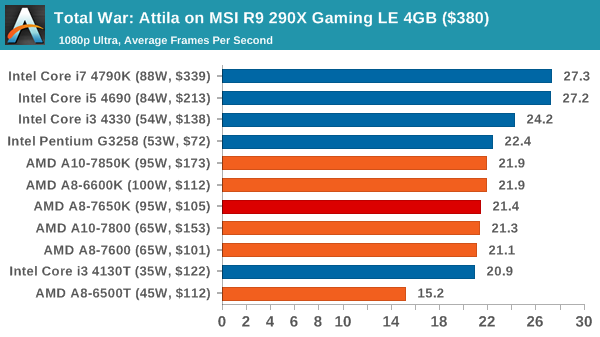
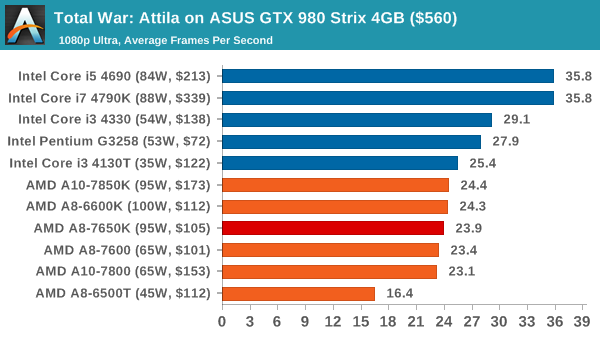
With both of our high end cards, the true quad cores from Intel give performance gains but the better performer here is the G3258 when considering price.
Grand Theft Auto V
The highly anticipated iteration of the Grand Theft Auto franchise finally hit the shelves on April 14th 2015, with both AMD and NVIDIA in tow to help optimize the title. GTA doesn’t provide graphical presets, but opens up the options to users and extends the boundaries by pushing even the hardest systems to the limit using Rockstar’s Advanced Game Engine. Whether the user is flying high in the mountains with long draw distances or dealing with assorted trash in the city, when cranked up to maximum it creates stunning visuals but hard work for both the CPU and the GPU.
For our test we have scripted a version of the in-game benchmark, relying only on the final part which combines a flight scene along with an in-city drive-by followed by a tanker explosion. For low end systems we test at 720p on the lowest settings, whereas mid and high end graphics play at 1080p with very high settings across the board. We record both the average frame rate and the percentage of frames under 60 FPS (16.6ms).
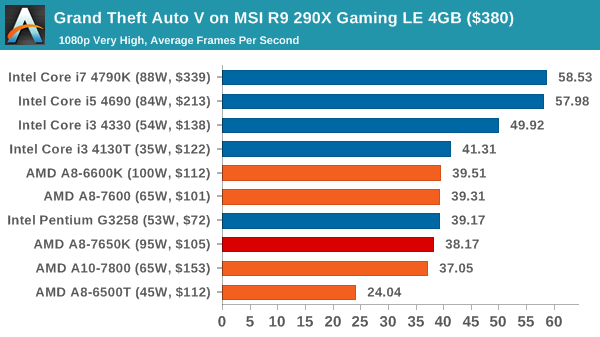
![Grand Theft Auto V on MSI R9 290X Gaming LE 4GB ($380) [Under 60 FPS]](https://images.anandtech.com/graphs/graph9217/74256.png)

![Grand Theft Auto V on ASUS GTX 980 Strix 4GB ($560) [Under 60 FPS]](https://images.anandtech.com/graphs/graph9217/74268.png)
The A8-7650K remains competitive in GTA around the $100 price point, but the i3-4130T for an extra $17 gets a slightly better score.
GRID: Autosport
No graphics tests are complete without some input from Codemasters and the EGO engine, which means for this round of testing we point towards GRID: Autosport, the next iteration in the GRID and racing genre. As with our previous racing testing, each update to the engine aims to add in effects, reflections, detail and realism, with Codemasters making ‘authenticity’ a main focal point for this version.
GRID’s benchmark mode is very flexible, and as a result we created a test race using a shortened version of the Red Bull Ring with twelve cars doing two laps. The car is focus starts last and is quite fast, but usually finishes second or third. For low end graphics we test at 1080p medium settings, whereas mid and high end graphics get the full 1080p maximum. Both the average and minimum frame rates are recorded.
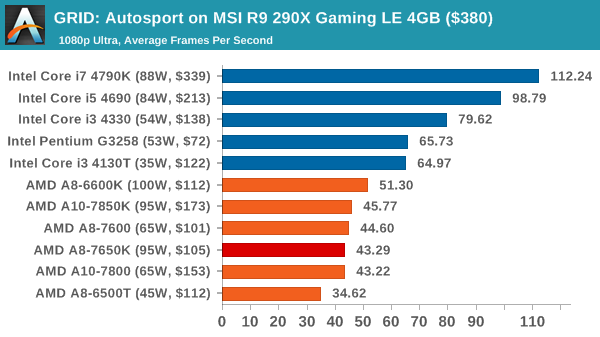
![GRID: Autosport on MSI R9 290X Gaming LE 4GB ($380) [Minimum FPS]](https://images.anandtech.com/graphs/graph9217/74258.png)
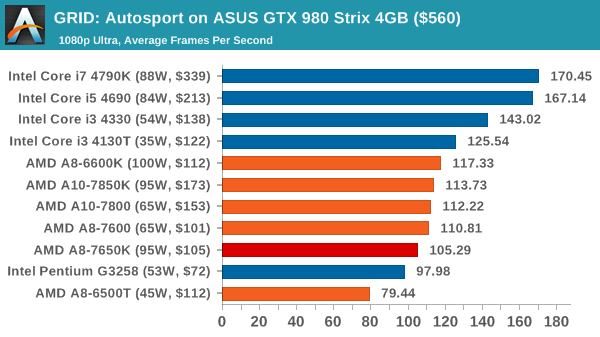
![GRID: Autosport on ASUS GTX 980 Strix 4GB ($560) [Minimum FPS]](https://images.anandtech.com/graphs/graph9217/74270.png)
GRID, as we saw on the other testing, still seems optimised for Intel CPUs. The minimum frame rates are the key metric here, especially on the R9 290X.
Middle-Earth: Shadows of Mordor
The final title in our testing is another battle of system performance with the open world action-adventure title, Shadows of Mordor. Produced by Monolith using the LithTech Jupiter EX engine and numerous detail add-ons, SoM goes for detail and complexity to a large extent, despite having to be cut down from the original plans. The main story itself was written by the same writer as Red Dead Redemption, and SiM received Zero Punctuation’s Game of The Year in 2014.
For testing purposes, SoM gives a dynamic screen resolution setting, allowing us to render at high resolutions that are then scaled down to the monitor. As a result, we get several tests using the in-game benchmark. For low end graphics we examine at 720p with low settings, whereas mid and high end graphics get 1080p Ultra. The top graphics test is also redone at 3840x2160, also with Ultra settings, and we also test two cards at 4K where possible.
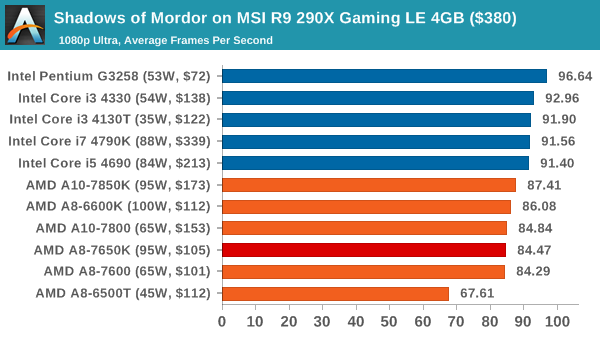
![Shadows of Mordor on MSI R9 290X Gaming LE 4GB ($380) [Minimum FPS]](https://images.anandtech.com/graphs/graph9217/74260.png)

![Shadows of Mordor on ASUS GTX 980 Strix 4GB ($560) [Minimum FPS]](https://images.anandtech.com/graphs/graph9217/74272.png)
SoM at 1080p shows small differences between AMD and Intel here, though you might be hard pressed to notice them.
Middle-Earth: Shadows of Mordor at 4K
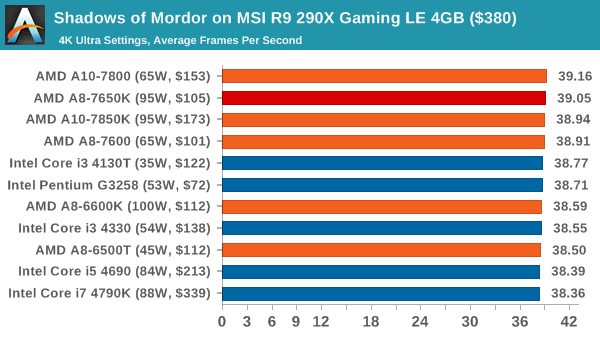
![Shadows of Mordor on MSI R9 290X Gaming LE 4GB ($380) [Minimum FPS]](https://images.anandtech.com/graphs/graph9217/74262.png)
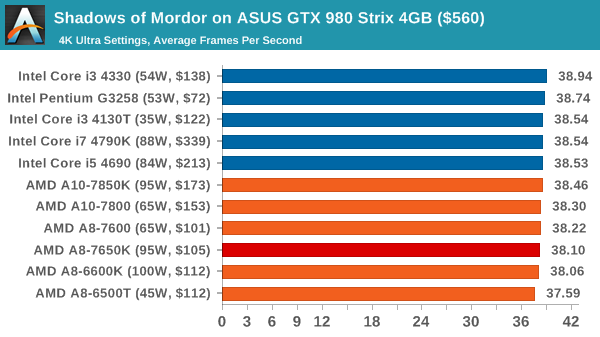
![Shadows of Mordor on ASUS GTX 980 Strix 4GB ($560) [Minimum FPS]](https://images.anandtech.com/graphs/graph9217/74274.png)
Moving to 4K evens out the average frame rates on all our CPUs, although a slight latter is appearing on the minimum frame rates.
Middle-Earth: Shadows of Mordor CrossFire at 4K
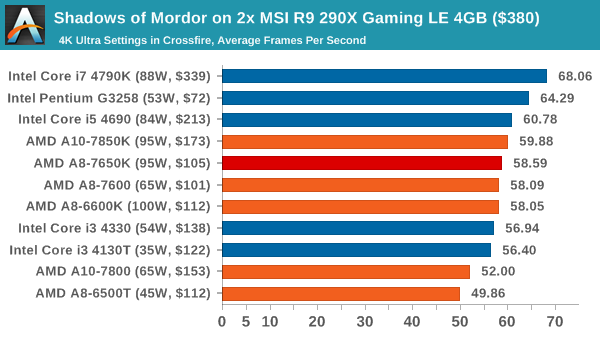
![Shadows of Mordor on 2x MSI R9 290X Gaming LE 4GB ($380) [Minimum FPS]](https://images.anandtech.com/graphs/graph9217/74264.png)
Bumping up to dual R9 290Xs shows that the A8-7650K is highly competitive in both average and minimum frame rates.















177 Comments
View All Comments
testbug00 - Tuesday, May 12, 2015 - link
Well, Broadwell is supposed to be out in 2013 according to Tick Tock. So, Intel's at least 1.5 years to their party. However, doing smaller nodes is REALLY hard. So, hard to blame them.azazel1024 - Tuesday, May 12, 2015 - link
Err, no. Haswell was 2013 and Ivy was 2012. Broadwell would have been summer of 2014. It ended up being a mostly paper launch in late fall 2014, with parts meaningfully showing up winter of 2015 and Intel mentioned up front that Broadwell would be a mostly mobile release.So they are perhaps 6 months late on Broadwell, but unless something different happens, Intel is still claiming summer/fall for Skylake, which puts them right back on the original schedule (and probably also why Broadwell is limited, Intel has known about their 14nm node issues for awhile, so they limited it to get the node out there and more experience on it and then jumping in to Skylake with both feet).
Ian Cutress - Tuesday, May 12, 2015 - link
I have the i5-5200U here in a BRIX that I can test, though it's worth noting that the 5200U list price is $281, more than any APU.takeship - Tuesday, May 12, 2015 - link
I was just thinking it wouldn't be too far off as a total cost comparison - a tall body i5 nuc + win 8 license + ram and scrounged up HDD/ssd is just about $600, which isn't too far above what a simple box with this would run. And my suspicion is that you don't give up too much gfx perf going down to the i3 and saving a hundred. Bandwidth being the bottleneck that it is.Refuge - Tuesday, May 12, 2015 - link
This SKU is new, but the chip is just a re-badge.extide - Tuesday, May 12, 2015 - link
A rebadge from what, exactly? No... It's not a rebadge, its just a lower model sku in a lineup that we have already seen. That is not what a rebadge is. We have not seen this core in this (or a similar) config released with a different sku before.Edens_Remorse - Wednesday, May 27, 2015 - link
Quit confusing the ignorants(shut up spell check, it's a word).duploxxx - Tuesday, May 12, 2015 - link
untill by the end of the year you start to see DX12 benchmarking :) and this more power silicon gets a free bump.25W is btw the difference in just a light bulb near your desktop or the minimal powerconsumption you have of dedicated gpu for the lack of onboard Intel GPU power :)
Michael Bay - Tuesday, May 12, 2015 - link
Yes, while all the action is in mobile segment. Where, you guessed it, AMD has no foothold.Not even mentioning DX12 being largely irrelevant this AND next year outside of useless synthetics.
duploxxx - Wednesday, May 13, 2015 - link
Carrizo is all about Mobile :)useless synthetics and benchmarking is all where Intel shines, the result bares show only better result, reall life daily use you don't even notice.